Abstract
The purpose of this study was to assess the metabolic profile and nutrient intake data in Korean adolescents according to exercise regularity using the forth Korean National Health and Nutrition Examination Survey from 2008 data. A total of 834 Korean adolescents (440 boys, 394 girls) aged 12 to 18 years were classified into exercising male (EM), non-exercising male (NM), exercising female (EF), and non-exercising female (NF) groups. EM exhibited significantly higher weight (P < 0.001), waist circumference (WC) (P < 0.01) and body mass index (BMI) (P < 0.001) than NM. EF showed significantly greater height (P < 0.01), weight (P<0.001), WC (P < 0.001), and BMI (P < 0.001) than NF. Although ratios of macronutrient intake were within the appropriate range in all groups, energy, riboflavin, vitamin C and calcium were assessed as in adequate by the nutritional adequacy ratio (NAR) in all groups. Moreover, EF and NF had inadequate intake of vitamin A and iron according to NAR, respectively. There were significant correlations between height and NAR protein (r = 0.249, P < 0.001), and mean adequacy ratio (MAR) (r = 0.177, P < 0.01), and between weight and NAR protein (r = 0.180, P < 0.01), and MAR(r = 0.136, P < 0.05) in EM. On the other hand, there were significant correlations between weight and NAR protein (r = 0.270, P < 0.01), WC and NAR protein (r = 0.271, P < 0.01), and BMI and NAR protein (r = 0.326, P < 0.01) in NM. There were significant correlations height and NAR Fe (r = 0.153, P < 0.05) in EF. However, there were no significant correlations between metabolic factors and nutritional adequacy in NF. Although we noted no significant differences in MAR between the groups, the exercising groups showed higher MAR values than the non-exercising groups. Therefore, practicing of ideal dietary behaviors appears to be induced through physical activity and regular exercise in Korean adolescents.
In Korea, current economic growth and improvements of standard of living have lead to decreases in various infectious diseases, but have led to large increases in chronic degenerative diseases due to lack of physical activity, excessive nutrient intake and high stress [1,2]. Among the chronic degenerative diseases, the frequency of obesity caused by lack of exercise has increased gradually whereas age at diagnosis has decreased, thus obesity in adolescents has risen quickly and becomes a critical health issue during adolescence [3]. According to the Korean National Health and Nutrition Examination Survey (KNHANES), obese adults having a BMI of 25 or within the criterion of the Korean Society for the Study of Obesity (KSSO) in Asians [4], increased continuously in Korea from 29.0% in 1998 to 31.7% in 2007 and the number of obese adolescents also increased approximately four times from 2.3% to 9.6% in the same period indicating that obesity has become a serious concern in adolescents [5].
Exercise as physical activity implies all physical movement promoting actual energy consumption through the contraction of skeletal muscle [6]. Physical inactivity in adults provokes various chronic diseases and problems related to skeletal muscle, mental health, and the immune system along with obesity [7] and lack of physical activity in children and adolescents has been reported to increase relative risks of many diseases including obesity and metabolic syndrome [8]. Generally, physical activity declines continuously with age [9]. Therefore, helping children and adolescents, who do not have established patterns of physical activity, to acquire healthy habits for increasing activity is useful in terms of public health, by leading to individual efforts to reduce occurrences diseases such as obesity, hypertension, and diabetes in adulthood [10]. As a basic condition for performing physical activity, it is important to acquire a habit of exercising regularly [11]. Regular exercise has been proven to decrease occurrence rates of chronic degenerative diseases, and it cam not be denied that exercise has such effects by being reciprocally related to other risk factors such as hypertension, obesity, diabetes, and hyperlipidemia [12-14]. In particular, since exercise during adolescence as well as adulthood is an important factor affecting occurrence rates of diabetes, hypertension, and cardiovascular disease along with having an influence on one entire life, it is therefore a major health variable [15].
Because adolescence is a time of experiencing dramatic physical and emotional development, as the periodic transition phase from childhood to adulthood, it demands high amounts of nutrients, thus a sufficient nutrient supply based on appropriate lifestyle and dietary habits is critical. However, most of Korean adolescents not only undergo psychological stress due to academic performance and examinations in middle and high schools, they also may adopt excessive weight control and unbalanced dietary habits due to attention on appearance, provoking failure to thrive following underweight and malnutrition, thus studies on adolescent health are desperately needed [5,16]. Because childhood and adolescence are important periods that require behavior adjustments and health policies to prevent chronic diseases, many efforts to investigate and analyze the health behaviors of adolescents have been made worldwide by dividing subjects into physical activity and dietary behavior groups, thus offering information to correct poor habits. However, most previous studies on adolescent health had a limitation of analyzing practice rates of recommendations of physical activity and dietary behavior independently [2,10]. Therefore, to enhance health by improving behavioral factors for health, a comprehensive rather than an independent approach considering both physical activity and dietary behavior is necessary, and strategies with a comprehensive approach to enhance health behavioral factors as well as mediate them need to be established.
Therefore, this study evaluated metabolic factors and nutritional quality according to exercise regularity and also analyzed correlations between metabolic factors and nutritional quality by investigating the practice of regular exercise in adolescents using raw data from the forth KNHANES performed in 2008. In addition, the results of this study can be expected to suggest new health approaches for Korean adolescents by helping them understand the importance of regular exercise as well as reconsidering the effects of exercise on ones metabolic profile and nutrient intake.
This study was carried out using data from the 2008 KNHANES conducted by the Korea Centers for Disease Control and Prevention. The subjects included a total 834 adolescents who answered all questions in the physical activity portion of the questionnaire with response such as 'practice of moderate-intensity exercise in difficult and breathed hard slightly in the last one week (slow swimming, tennis doubles, volleyball, badminton, table tennis, occupational or physical educational activities such as carrying a light item), 'practice of high-intensity exercise is very difficult and breathed hard in the last one week (running, fast cycling, fast swimming, soccer, basketball, jump rope, squash, tennis singles, occupational or physical educational activities such as carrying a heavy item)' and 'walked for over 10 minutes each day in the last one week'. The total 834 subjects had participated in both the physical examination and nutrition surveys, among 900 individuals aged 12 to 18 years who had participated in the entire questionnaire survey on health, physical examination, and nutrition in adolescents. The total subjects included 440 boys and 394 girls.
All subjects were classified into exercise and non-exercise groups by determining whether to exercise expended over 1,000 kcal per week and according to the criterion suggested by the American College of Sports Medicine (2006) for preventing chronic disease in sedentary people. For this, by using the number of day(s) of exercise in a week and exercise time per day, exercise time per week (min.) was calculated and converted into calories. Calories were calculate by designating intense and moderate physical activity and walking as 7, 5 and 4 METs, respectively [17]. Using the calculated values, the male and female adolescents were divided into exercising groups that performed exercise that expended over 1,000 kcal in the last one week or a control group that did not exercise or expended less than 1,000 kcal through exercise, in the last one week. In other words, all subjects were classified into one of the following groups; exercising male group (EM), non-exercising male group (NM), exercising female group (EF) and non-exercising female group (NF).
To investigate the physical characteristics of the subjects, height, body weight, waist circumference and BMI were measured as well as final values of systolic and diastolic blood pressure during the physical examination survey.
For biochemical assessment, glucose, TC, TG, hemoglobin and hematocrit levels were analyzed in the physical examination survey.
Nutrient intakes were investigated with data from the nutrition survey of KNHANES, which used the 24-hour recall method. Based on this data, average daily intakes of nutrients per person were determined for each adolescent according to recommended levels by the Dietary Reference Intakes for Koreans (KDRI's) [18], including protein, Ca, P, Fe, vitamin A, thiamin, riboflavin, niacin and vitamin C. To assess nutritional adequacy, nutritional adequacy ratio (NAR) and mean adequacy ratio (MAR) were calculated using the KDRI's as standards and a level of over 1.0 was determined as adequate. All NAR values were truncated at 1.0 to prevent intakes in excess of the RDAs for nutrients by compensating mathematically for low intakes of other nutrients that could not be substituted nutritionally [19,20].
The data were expressed as means ± SE using the SPSS/PC program (version 15.0 for windows; SPSS Inc., Chicago, IL, USA). Subject composition was analyzed using frequency analysis and differences in all variables between EM and NM and between EF and NF, and was verified using independent sample t-tests for continuous variables and Chi-square tests for categorized variables. To analyze correlations between variables of metabolic profile variable showing a significant difference with nutritional adequacy, Pearson's correlation coefficient (r) was calculated. Differences were considered statistically significant at P < 0.05.
The composition of the study subjects is shown in (Table 1). The 834 adolescents consisted of 440 boys (52.8%) and 394 girls (47.2%). Among them 331 boys (75.2%) and 192 girls (48.7%) responded that they performed regular exercise, which expended over 1,000kcal per week, while 109 boys (13.1%) and 202 girls (24.2%) did not exercise or performed exercise that expended less than 1,000kcal per week (P < 0.001).
The physical characteristics of the subjects are presented in (Table 2). The average age of all subjects was 14.6 years. Although there were no significant differences in average age and systolic and diastolic blood pressure between the groups, body weight (P < 0.001), BMI (P < 0.001), and WC (P < 0.01) were significantly higher in EM than in NM. In addition, height (P < 0.01), body weight (P < 0.001), WC (P < 0.001) and BMI (P < 0.001) were significantly higher in EF than in NF.
The composition of the subjects according to BMI is shown in (Table 3). The 331 male adolescents in EM consisted of 79 underweight (23.9%), 238 normal weight (71.0%) and 14 obese (4.2%) subjects. In addition, the 109 NM adolescents consisted of 42 under weight (38.5%), 57 normal weight (52.3%) and 10 obese (9.2%) subjects (P < 0.01). On the other hand, the 192 female adolescents in EF, consisted of 36 underweight (18.8%), 150 normal weight (78.2%) and 6 obese (3.1%) subjects, and the 202 adolescents in NF consisted of 75 underweight (37.1%), 121 normal weight (60.0%), and 6 obese (2.9%) subjects (P < 0.001).
The subjects' biochemical metabolic profile data are shown in (Table 4). Glucose, TC, TG, hemoglobin, and hematocrit were not significantly different between groups.
The nutrient intakes of the subjects are presented in (Table 5). When acceptable macronutrient distribution ranges (ADMR) were analyzed, all groups were within acceptable ranges for individuals aged 3-19 years with respects to carbohydrate : protein : lipid (55-70% : 7-20% : 15-30%). In addition, analyses of differences in daily nutrient intake between groups revealed that while the female did not show statistically significant differences between groups, the males in EM consumed significantly more niacin and potassium than those in NM (P < 0.05).
The analysis results for nutritional adequacy of the subjects are presented in (Table 6). Upon comparing NAR and MAR between groups, EF and NF did not show significant differences but EM was asses within an adequate NAR for niacin and consumed significantly more niacin than NM (P < 0.05).
In the analysis of NAR, all groups were assessed as inadequate in riboflavin, vitamin C and Ca intakes. Vitamin A intake and niacin intake were assessed as inadequate in EM and NM, respectively. In addition, vitamin A and Fe intakes were assessed as inadequate in EF and NF. MAR analysis revealed that only EM had adequate intake.
Correlations between nutritional adequacy and metabolic factors according to gender are shown in (Table 7) and (Table 8). In EM, height had a significantly positive correlation with NAR protein (r = 0.249, P < 0.001), NAR thiamin (r = 0.041, P < 0.05), NAR niacin (r = 0.251, P < 0.001), NAR P (r = 0.188, P < 0.01), NAR Fe (r = 0.141, P < 0.05) and MAR(r = 0.177, P < 0.01), and body weight had significantly positive correlation with NAR protein (r = 0.180, P < 0.01), NAR niacin (r = 0.144, P < 0.05), NAR P (r = 0.142, P < 0.05) and MAR (r = 0.136, P < 0.05). In NM, body weight had significantly positive correlation with NAR protein (r = 0.270, P < 0.01), NAR riboflavin (r = 0.227, P < 0.05), NAR niacin (r = 0.272, P < 0.01) and NAR P (r = 0.248, P < 0.05) and WC showed significantly positive correlations with NAR protein (r = 0.271, P < 0.01) and NAR niacin (r = 0.254, P < 0.05). BMI was significantly positively related to NAR protein (r = 0.326, P < 0.01), NAR niacin (r = 0.284, P < 0.01), and NAR P (r = 0.287, P < 0.01).
For correlations between nutritional adequacy and metabolic factors in the female adolescents, EF showed a significantly positive correlation between height and NAR Fe (r = 0.153, P < 0.05). However, there were no significant correlations between metabolic factors and nutritional adequacy in NF.
KNHANES is a nationally approved statistical survey on health and nutritional condition conducted according to the law for national health promotion. The raw data used in this study were from the second year of the fourth KNHANES from January to December, 2008. Although the number of adolescents in the original raw data was 900, this study analyzed data from 834 of these subjects, consisting of 440 boys and 394 girls who answered all of the questions in the questionnaire for adolescents aged 12-18 years and participated in all surveys, in order to increase the reliability of the study results.
Out of the total subjects in this study, 75.2% of the boys (331) and 48.7% of the girls (192) were found to perform regular exercise that expended over 1,000 kcal per week. This finding is similar to other studies reporting that male adolescents did more exercise than female adolescents [21-23] and suggests that research on active participation of girls in exercise and measures to promote their participation are necessary.
The average age of the subjects was 14.6 years, and average height, body weight and BMI were 167.3 cm, 58.8 kg and 20.9 kg/m2, respectively in the male adolescents, and 158.8 cm, 52.0 kg and 20.5 kg/m2, respectively in the female adolescents. As compared to levels of height, body weight and BMI for boys (164.3 cm, 56.7 kg, and 21.0 kg/m2, respectively) and girls (158.4 cm, 51.5 kg and 20.5 kg/m2, respectively) aged 14 years reported by the Ministry of Education and Human Resources Development and the Korean Educational Development Institute (KEDI) [24], the boys' height and body weight were 3.0 cm and 2.1 kg higher, respectively and the girls' height and body weight were recorded as 0.4 cm and 0.5 kg higher, respectively. Interestingly, although the average BMIs of the boys and girls observed in this study were similar to those determined by the Ministry of Education and Human Resources Development and KEDI, the physiques of the subjects in this study, including height and body weight were found to be improved. This study showed that EM recorded significantly higher levels of body weight, waist circumference, and BMI than NM. In addition, EF had significantly higher levels of height, body weight, waist circumference and BMI than NF. The results indicate that the physiques of adolescents who exercised regularly were better than those of adolescents who did not. However, this is contrary to the results of previous studies revealing that in exercising groups, body weight was significantly lower than in non-exercising groups [5,25]. Considering that the normal range of BMI reported by KSSO was 18.5-25.0 for both males and females, and a standard physique as determined by the KDRI's was a BMI of 22.0 kg/m2, the adolescents doing regular exercise had significantly higher body weights and BMIs than the other subjects, however, their levels were within the normal range and rather was nearer to the standard. Therefore, regular exercise can be helpful in maintaining and managing a standard physique for both of boys and girls.
Most cross-sectional studies [26,27] have not shown any significant correlations between a regular exercise and variables of metabolic syndrome in children and adolescents. In the third survey, KNHANES investigated physical activity with an International Physical Activity Questionnaire (IPAQ) according to frequency and time of walking, and moderate-intensity and severe-intensity physical activity. This study, which calculated calories by designating intense and moderate physical activity and walking, also revealed there were no significant differences according to exercise in hemoglobin and hematocrit levels or glucose, TC and TG. This is considered to be because the adolescents in all groups of this study were within normal ranges for metabolic profile data. Meanwhile, HDL-C level could not be analyzed in this study since it was not included in the available raw data of KNHANES.
When the nutrient intakes of all subjects were investigated according to exercise, there were no significant differences between groups, except for higher niacin and potassium intakes of EM compared to NM. Major sources of niacin are poultry, wheat bran, tuna and other fish, whereas fresh fruits, vegetables, milk, whole grains, and meats are sources of potassium [18]. In the present study, the adolescents who exercised showed greater niacin and potassium intake than the non-exercising adolescents. Although it was not presented in this study, this result was due to the exercising adolescents having dietary habits of greater milk and meat intake. These results are similar to previous studies. According to previous investigations on dietary intake in Korean adolescents [10,15], the rate of exercising adolescents who practiced recommendations for daily intakes of meat, milk, and milk products was significantly higher than that of the non-exercising adolescents. NAR is used to evaluate the dietary adequacy of individual nutrients, and MAR is a method to assess dietary adequacy of overall nutrients. NAR and MAR values of over 1.0, respectively, indicate adequate intake conditions [1,3,19,20]. To evaluate dietary adequacy properly, both NAR and MAR should be calculated and used for assessment, thus this study utilized both values. MAR assessing the appropriateness of overall nutrients, indicated that all groups except EM had inadequate intake, and therefore the qualitative dietary intake of Korean adolescents is considered to be a problem. NAR analysis showed that in all groups riboflavin, vitamin C and Ca intakes were inadequate. Regardless of exercise regularity, NAR vitamin A and NAR Fe intakes were assessed inadequate in female adolescents. According to other reports on dietary intake in adolescents [2,17,21], the rate of boys practicing recommendations for daily intake of fruits and vegetables was significantly lower than that of girls, and the rate of boys practicing recommendations for daily intakes of meat and protein was significantly higher than that of girls. However, this study showed that in both male and female adolescents, protein intake was assessed as adequate but vitamin C intake was not.
When correlations between metabolic profile values and nutritional adequacy were analyzed, a significantly positive correlation was observed between height and NAR Fe in the exercising groups of both boys and girls. This finding indicates that exercise worked as a factor promoting increased height and intake of iron. Similar to the results of other studies revealing that exercise positively affected physical development in adolescents [28-31], this study also found that exercise produced positive effects on physical development. The rate of participation in exercise was higher in male students than in female students at 75.2% and 48.7%, respectively, and EM was observed to be good in terms of height and body weight and in the appropriateness of MAR. Among the female adolescents, physical development was significantly poorer in NF than in EF, and NF recorded the lowest level of 0.91 in MAR analysis. This result indicates that inactivity in girls negatively influenced physical development and nutrient intakes and suggests that efforts to provoke physical development and improvements in nutrient intake by inducing their participation in exercise are necessary. Similar to the findings of previous studies reporting that female students had a high interest in appearance but tended not to practice healthy behaviors in terms of physical activity and dietary behavior [2,17,23], this study revealed that the rate of girls not practicing healthy behaviors in terms of physical activity and dietary behavior was high and that they needed to practice these behaviors. According to a study by Lee and Lee [32] on dietary habits and exercise in underweight and obese adolescents, when adolescents have the habit of enjoying exercise rather than focusing on consuming calories through exercise, obesity can be prevented thus physical training should be a required subject rather than an optional one and class time should be extended to promote and enhance physical strength. This study also indicates that practice of dietary behaviors needs to be induced through practice of regular physical activity and exercise in Korean adolescents. In particular exercise programs and nutrient education programs are necessary for girls to help them create habits toward enjoying exercise.
According to the above results, regular exercise by Korean adolescents is considered to affect physical characteristics and nutritional adequacy, and efforts to induce the active participation of female students in exercise are desperately needed. To promote active participation by girls, appropriate recognitions of appearance and health must be made and strategic health education with comprehensive approach strategies including practices of voluntary and healthy exercise and dietary habits should be provided.
References
1. Cho KO. A comparative study assessing metabolic profile and diet quality in college women according to their mother's diabetes mellitus. J Korean Diet Assoc. 2009; 15:1–9.
2. Kim JW, Kong SA, Lee O, Kim CZ, Kim YS. Patterns and interrelationships for meeting recommendations of physical activity, and sedentary and dietary behavior in elementary school students. Korean J Community Living Sci. 2009; 20:81–89.
3. Park YS, Kwon MK. A study on the nutritional status and eating behaviors of underweight adolescent females, aged 15 to 19 years, using data from 2001 NHANS of Korea. J Korean Home Econ Assoc. 2007; 45:1–11.
4. Korean society of the study of obesity. Clinical obesity. 2001. 2nd. Seoul: Korea medicine Publishing;p. 11–59.
5. Moon SS, Lee YS. Comparison of dietary habits, exercise, recognized body shapes and weight control between obesity and underweight of adolescents. Korean J Hum Ecol. 2009; 18:1337–1348.

6. American College of Sports Medicine. ACSM's guidelines for exercise testing and prescription (7th). 2006. Baltimore: Lippincott William & Wilkins;p. 216.
7. Warburton DE, Nicol CW, Bredin SS. Health benefits of physical activity: the evidence. CMAJ. 2006; 174:801–809. PMID: 16534088.

8. Körner A, Kratzsch J, Gausche R, Blüher S, Kapellen T, Pulzer F, Behrens M, Kiess W. Metabolic syndrome in children and adolescents--risk for sleep-disordered breathing and obstructive sleep-apnoea syndrome? Arch Physiol Biochem. 2008; 114:237–243. PMID: 18946784.
9. Planinsec J, Matejeck C. Differences in physical activity between non-overweight, overweight and obese children. Coll Antropol. 2004; 28:747–754. PMID: 15666607.
10. Kim YS, Kong SA, Lee O, Kim JW, Kim CZ, Park IH. The relation between physical activity and fitness in children. Exerc Sci. 2008; 17:495–504.
11. National Association for Sport and Physical Education. Physical education for life-long fitness. 2005. Baltimore: Human Kinetics;p. 30–45.
12. Cho KO, Lee HJ. The effects of regular exercise on obesity indices and dietary factors in adult males. Korean J Community Nutr. 2007; 12:160–167.
13. Kim KH. Comparisons of dietary, living habits and blood parameters in underweight and overweight university students. Korean J Food Cult. 2006; 21:366–374.
14. Lee KY, Kim SY, Jun TW. The effect of combined training at different times of day on body composition, plasma lipids, stress hormones and nutrient intakes. Korean J Community Nutr. 2006; 11:143–151.
15. Cho KO, Kim YS. Evaluations of physical development and diet quality in Korean adolescents according to exercise regularity; using the forth Korean national health and nutrition examination survey, 2007. Korean J Growth Dev. 2010; 18:137–144.
16. Fujii K, Tanaka N, Ishigaki T, Hanaik T, Kim SH, Nho HS. Confirmation regarding physical fitness based on polynomial regression evaluation of body fat percentage for BMI in adolescence. Korean J Growth Dev. 2008; 16:43–47.
17. Driskell MM, Dyment S, Mauriello L, Castle P, Sherman K. Relationships among multiple behaviors for childhood and adolescent obesity prevention. Prev Med. 2008; 46:209–215. PMID: 17714771.

18. Korean Nutrition Society. Dietary reference intakes for Koreans. 2006. Seoul: The Korean nutrition society;p. 23–28.
19. Gibson RS. Evaluation of nutrient intake data. Principles of nutritional assessment 1990. p. 137–154.
20. Guthrie HA, Scheer JC. Validity of a dietary score for assessing nutrient adequacy. J Am Diet Assoc. 1981; 78:240–245. PMID: 7217578.

21. Eaton DK, Kann L, Kinchen S, Ross J, Hawkins J, Harris WA, Lowry R, McManus T, Chyen D, Shanklin S, Lim C, Grunbaum JA, Wechsler H. Youth risk behavior surveillance-United State, 2005. MMWR Surveill Summ. 2006; 55:1–108. PMID: 16760893.
22. Kim YH, Cho JH. The relationship between physical activity pattern, dietary habit, body mass index and health-related physical fitness for elementary school children. J KSME. 2002; 4:63–81.
23. Sanchez A, Norman GJ, Sallis JF, Calfas KJ, Cella J, Patrick K. Patterns and correlates of physical activity and nutrition behaviors in adolescents. Am J Prev Med. 2007; 32:124–130. PMID: 17197153.

24. Ministry of education, science and technology & Korean educational development institution. 2009 Statistical yearbook of education. 2009. Seoul: The Korean educational development institution;p. 100–107.
25. Son SM, Park ES. A study on body weight control and dietary habits according to the obese index in male middle school students. Korean J Community Nutr. 2006; 11:683–694.
26. Brage S, Wedderkopp N, Ekelund U, Franks PW, Wareham NJ, Andersen LB, Froberg K. European Youth Heart Study (EYHS). Features of the metabolic syndrome are associated with objectively measured physical activity and fitness in Danish children: the European Youth Heart Study (EYHS). Diabetes Care. 2004; 27:2141–2148. PMID: 15333475.
27. Rizzo NS, Ruiz JR, Hurtig-Wennlof A, Ortega FB, Sjostrom M. Relationship of physical activity, fitness, and fatness with clustered metabolic risk in children and adolescents: the European youth heart study. J Pediatr. 2007; 150:388–394. PMID: 17382116.

28. Ainsworth BE, Haskell WL, Whitt MC, Irwin ML, Swartz AM, Strath SJ, O'Brien WL, Bassett DR Jr, Schmitz KH, Emplaincourt PO, Jacobs DR Jr, Leon AS. Compendium of physical activities: an update of activity codes and MET intensities. Med Sci Sports Exerc. 2000; 32:S498–S504. PMID: 10993420.

29. Jeong DS. Characteristics of growth and development oh physique and health-related physical fitness of elementary school students. Korean J Sports Sci. 2004; 13:789–800.
30. Lim BK, Kim HG. Assessment of health grade by physique and physical development index and healthy-life habits in elementary school students. Korean J Growth Dev. 2004; 12:17–28.
31. Park TS. For the degree of contributions of socio-environmental factors and physical growth affecting physical development. Korean J Growth Dev. 1993; 1:78–90.
32. Lee JE, Lee IH. Classification of eating disorder patterns of female middle school students and their association with self-body image, weight control behavior, and eating behavior. Korean J Community Living Sci. 2006; 17:89–103.




 PDF
PDF ePub
ePub Citation
Citation Print
Print



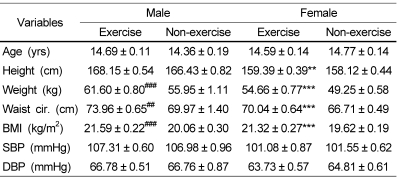

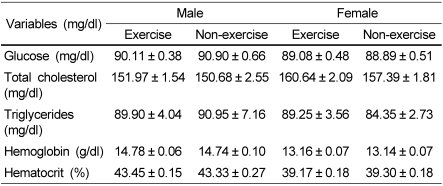
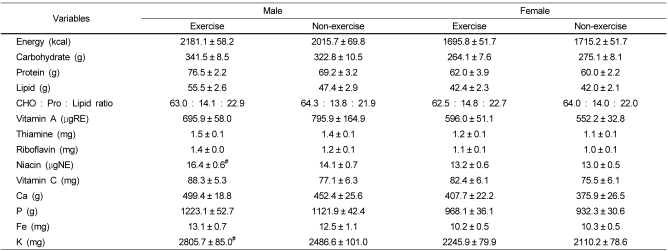
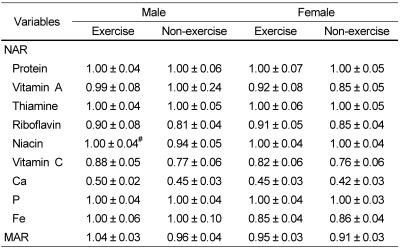
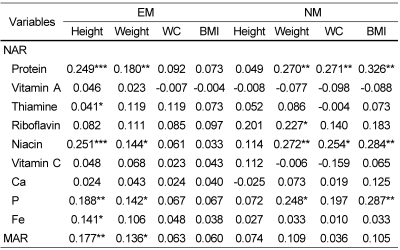
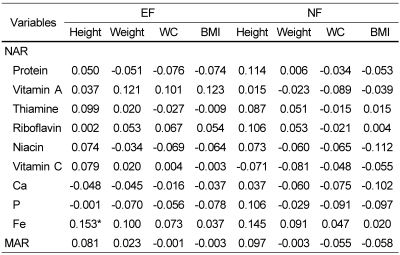
 XML Download
XML Download